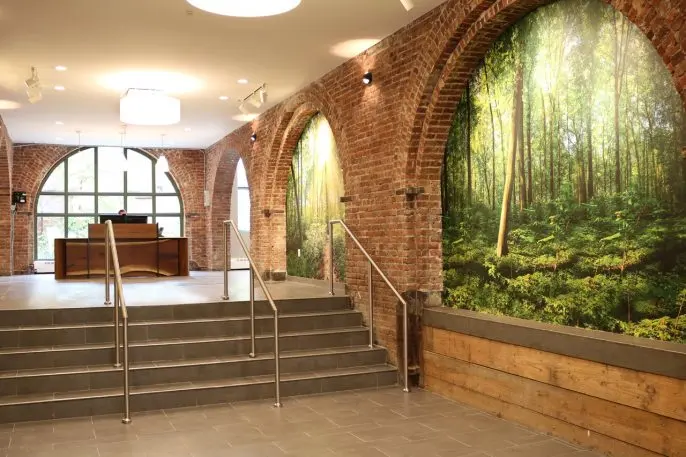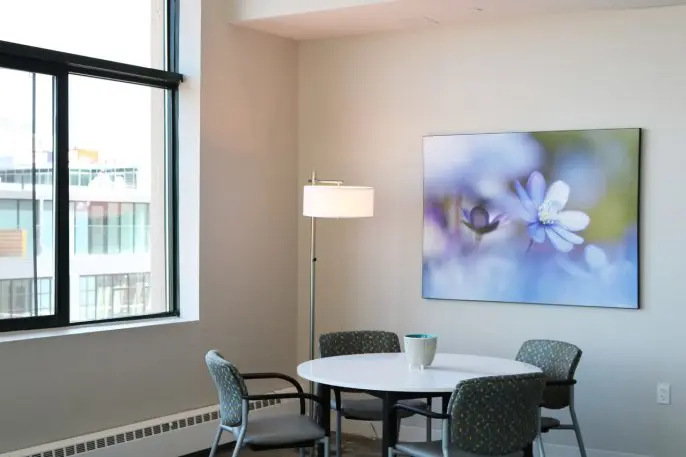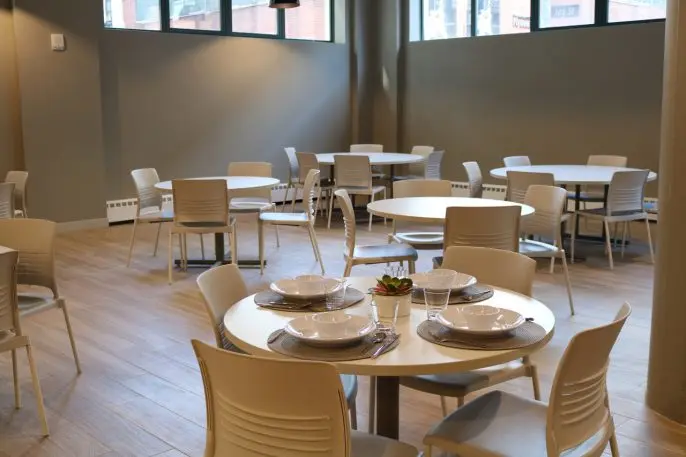The dining room at the front of the six-story former paint factory in the trendy Brooklyn waterfront neighborhood of DUMBO is well-lit; light pours in through high windows that line the top of the room. The tables are round, and on them sits a hipster’s feast: an egg sandwich made with smoked salmon and marinated cucumbers, ancient grain porridge decorated with stewed blueberries, banana bread topped with peach compote, and of course, avocado toast.
If this were a celebrity-filled rehab center, you wouldn’t bat an eye. But this facility is specifically intended to serve working, middle-class New Yorkers, who can’t pay out of pocket for luxury treatment but who have insurance through their employers.

With the United States gripped by an opioid epidemic that has been labeled the deadliest drug crisis in the country’s history, responsible for one in every 50 deaths in 2015, stereotypes of people addicted to substances like heroin and fentanyl have emerged and solidified. These images yoke substance abuse and addiction to factors like rural poverty and unemployment, and revolve around overburdened treatment centers like methadone clinics that have done little to break the cycle of addiction.
Phoenix House opened its first treatment center in New York in 1967, and has since grown to six facilities across New York City and Long Island, offering a variety of inpatient, outpatient, and detox programs for people struggling with drug and alcohol abuse. Although Phoenix House is a nonprofit organization, just around 5% of its annual revenue of around $141 million comes from grants and donations–the remainder is pretty neatly split between client and third-party revenue, and government contract revenue.

“When we were figuring out what type of program we wanted to develop in here, we actually talked to a lot of payers in the city–employee assistance programs, unions–and heard from them that there just weren’t enough good drug rehabilitation programs that took employer-based insurance,” says Benjamin Nordstrom, senior vice president and chief clinical officer at Phoenix House. Those payers, Nordstrom adds, would often end up directing people to out-of-state facilities for sustained addiction treatment, and upon their return to New York, hand them off to an outpatient facility like a hospital to maintain care. “We wanted to build something that works, and that keeps people in place,” Nordstrom says. One of Phoenix House’s upstate New York locations was also the subject of an investigation in 2013 that found the organization was falling short on delivering the required 40 hours of therapy to patients, many of whom were continuing drug use while at the facility. Positioning the Phoenix Life Center as a new model of care could be sending a signal to the rest of the network that standards of treatment must be raised and adhered to.

The Phoenix Life Center in DUMBO is designed, Nordstrom adds, specifically to fill that void. It is a drug and alcohol addiction rehab center for the middle class, and takes all local employer-based insurance plans, but not Medicaid. (Even though all employer-based insurance plans are mandated by the Mental Health Parity and Addiction Equity Act of 2008 to cover rehab, many facilities will restrict which plans they accept, making the search for a compatible treatment option difficult.) Patients can access the Phoenix Life Center the same way they would any other Phoenix House facility: by calling and making an appointment, or by walking into the assessment center housed on the ground floor. Phoenix House operates around a “no wrong door” policy, Nordstrom says. Those patients on Medicaid are directed away from the Life Center and toward the Phoenix House facility in Long Island City, which is just visible through the living room window on the women’s floor at the Life Center, six floors up. The Long Island Facility is also residential, though the quality of its food and lodging are not up to the standard of the new DUMBO facility. However, the Long Island City outpost will, by 2020, become a Phoenix Life Center, along with around 15 to 20 other centers across the U.S., says Ashley Womble, Phoenix House’s communications director. Those converted facilities that took Medicaid initially will continue to do so once they convert to Phoenix Life Centers.

“There’s a danger that you can turn a residential facility into a bubble, where people can keep it together in just a very controlled, monitored environment,” Nordstrom says. “What we want people to do here is, essentially, to rehearse behaviors and habits they can then bring back out with them.” To that effect, patients at the Life Center are allowed to keep their phones on them as they go through treatment to encourage a sense of continuity with their lives and people close to them; the Life Center will also host Alcoholic Anonymous, SMART Recovery, and Women for Sobriety meetings to give patients access to groups who will support their rehabilitation once they leave the center.

The Phoenix Life Center is less than a month old. It’s still very much, as Nordstrom says, an experiment in the realm of addiction treatment. But the Phoenix House leadership is confident that their new model will be effective in treating addiction more holistically and continuously. Because there is only one Life Center currently open, though, it can’t help but also exacerbate the inadequacies in the addiction treatment facilities currently available to people in need, especially those on Medicaid who can’t afford luxury care. That, Nordstrom says, is almost the point. Phoenix House is one of the largest nonprofit addiction services networks in the U.S., he says, and they want to prove, through establishing more Life Centers and making them available to middle-class and lower-income people on Medicaid and employer-based insurance programs alike, that this can and should be the standard of care. “We want to raise the bar and set the pace,” he says, “and encourage everyone to catch up with us.”
Recognize your brand’s excellence by applying to this year’s Brands That Matter Awards before the early-rate deadline, May 3.
